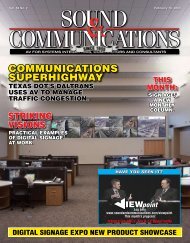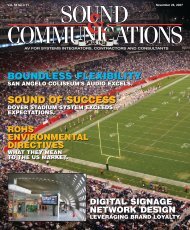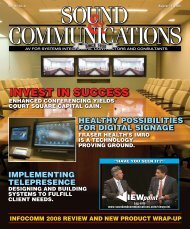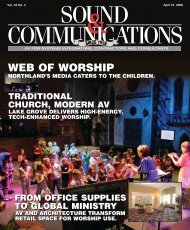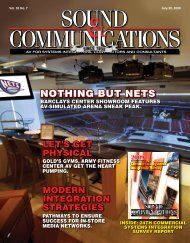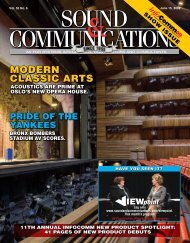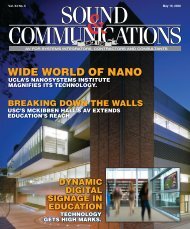May 2009 - Sound & Communications
May 2009 - Sound & Communications
May 2009 - Sound & Communications
Create successful ePaper yourself
Turn your PDF publications into a flip-book with our unique Google optimized e-Paper software.
Standards For The AV IndustryThe compliance touchstone for serious, passionate pros.By David H. DirksAs a professional industry witha long track record, it is amazingthat the AV industry lacks even themost basic universal, agreed-uponstandards. Broadcast television isstandards driven. The movie industryis driven by standards. Why not AV?Sure, there are standards addressingkey components of AV: compressionformats, perhaps, or video waveforms. What I hear, though, is a callfrom integrators and managers oflarge AV enterprises for standardsthat create uniform integration andinteroperability.People are tired, I think, of tryingto maintain systems based on componentsthat should work together, butoften don’t for a variety of reasons.The challenge one faces when embracingthe topic of standards is thatthere is, first of all, a debate on whywe need them.Before 24-hour cable dominatednews broadcasting—when broadcasttelevision dictated when, whereand how each of us received thenews—there existed a universallyaccepted and adhered to “broadcaststandard.” The broadcast standardset the requirements for all aspectsof broadcast, including field video.Source material for any over-the-airbroadcast had to meet strict engineering-basedcriteria. In practice,the broadcast standard embracedmore than engineering: It embodiedan operational philosophy, as well. Itstood as the reference for quality andexcellence.In the early 1980s, the first 24-hour news network, CNN, broadcastthe first news report from the fieldsourced from a consumer camcorder.The video was soft and lacked thedefinition and quality associated withthe “broadcast standard.” The transmissionwas the first use of ½-inchVHS tape for on-air news reporting.Those of us who grew up with the“broadcast standard” were mortified.If the broadcast standard did notstand, what would stand?Let’s move past the basic debate,for a moment, and assume that wecan gather consensus that standardshave to be established. The nexthurdle is, “What do we standardize?”That is where the discussionhas to start. In our industry, there isno reference standard that not onlyencompasses critical engineeringcriteria (signal levels, timing and interoperability)but also embodies thephilosophy of the industry (quality,reliability and excellence).An AV Standard would be the compliancetouchstone for those who areserious about the business and passionateabout results. Moreover, ourindustry has become part of the criticalcommunications infrastructure.Standards help us define what “good”means and enable us to respond tothe reliability requirements our usersare demanding. Our industry is moreakin to the comments I once heardat a professional society conferencewhere an engineer presented a paperon a new compression algorithm withthis introduction: “I love standards.Standards are great. Standards arewonderful, because everybody canhave their own.”Let me give an example as a pragmaticstarting point. Currently, mostcontrol systems and devices aredesigned to work around RS232. AlthoughRS232 should work adequately,it does not. Interfaces will not workat the highest baud rates with largeenough buffers to prevent overflow.When building a large, complex systemwith a touchpanel control system, thewiring is unwieldy and the system,despite enormous advances in microprocessorpower and data rates, runslike a jalopy. The result is user frustrationwhen the control system does notoperate fast enough or hangs when toomany buttons are pushed in sequence.How much better would it be fordesigners and integrators to fullyembrace, promote and improve uponsome other already-established, highspeedprotocol with simplified cablingand no distance limitation? It wouldthen make sense to work with otherstandards organizations to assign signalingbits to the high-speed transportthat can be designated for AV functionsonly.And what of all the other areas ofstandardization? We need standardsfor wiring, audio levels, video levels (Ithought those were established, but apparentlynot), interfaces, etc. etc.There is a lot of buzz in the industryabout the need for standards. In ourwork at Sandia National Laboratories,we have made the effort to publishcollaboration and AV standards for thecorporation. Our publications establishstandards for audio levels, acoustics,video levels, interface requirements,David H. Dirks is principal member of the Videoconference and Collaborative Technologiestechnical staff at Sandia National Labs, Livermore CA.32 <strong>Sound</strong> & <strong>Communications</strong>www.soundandcommunications.com




